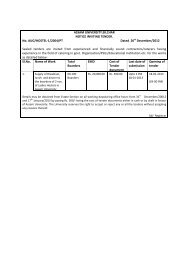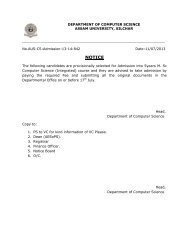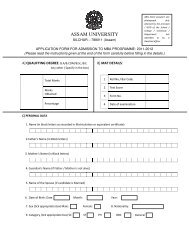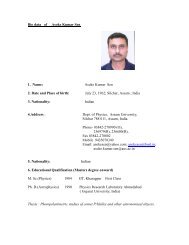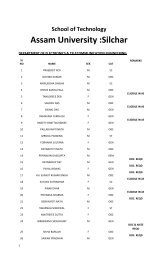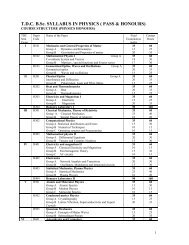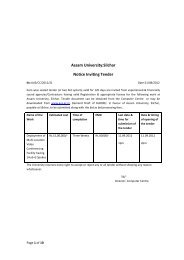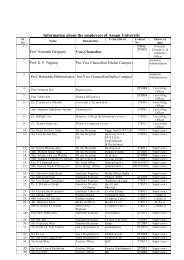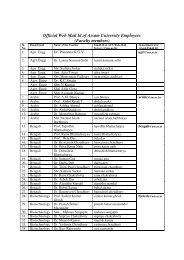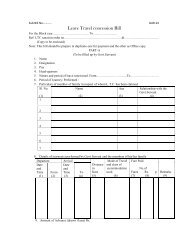International Seminar on Human Development ... - Assam University
International Seminar on Human Development ... - Assam University
International Seminar on Human Development ... - Assam University
You also want an ePaper? Increase the reach of your titles
YUMPU automatically turns print PDFs into web optimized ePapers that Google loves.
development status of the marginalized secti<strong>on</strong>s <strong>on</strong>e perceives in the regi<strong>on</strong>? What factor ultimately determines the human development ofthe marginalized people in the regi<strong>on</strong>? In the c<strong>on</strong>text of the efforts made thus far for uplift of the regi<strong>on</strong>’s people, the cause of theirperpetual marginality with low human development seems to narrow down to governance, the prominent actors of which currently aregovernment, n<strong>on</strong>-government organizati<strong>on</strong>s, market and civil society organizati<strong>on</strong>s. <strong>Human</strong> development which is in real sense a newapproach to empowerment of people can be used to overcome the deficiencies of the <strong>on</strong>-going development and governance.‘<strong>Human</strong> <strong>Development</strong>’ as a new paradigm of development theory brings people into the centre stage of development, c<strong>on</strong>sidering them thereal wealth of a nati<strong>on</strong> and quality of their life as end to be pursued through the means of Gross Domestic Product (GDP) or ec<strong>on</strong>omicgrowth. The United Nati<strong>on</strong>s <strong>Development</strong> Programme (UNDP), in its first report <strong>on</strong> human development (1990), c<strong>on</strong>ceived it as “enlargingpeople’s choices” which are varied and changing over time. The UNDP’s c<strong>on</strong>cept covers widely accepted three critical dimensi<strong>on</strong>s ofpeople’s well being; namely, (i) a l<strong>on</strong>g and healthy life, (ii) access to knowledge and skills and (iii) c<strong>on</strong>trol over resources to ensure a decentstandard of living. Taking into account the three broad parameters, the UNDP envisages measuring the people’s welfare by way ofc<strong>on</strong>structing composite <strong>Human</strong> <strong>Development</strong> Index (HDI). Recognizing the existence of gender disparity in development process the UNDPsubsequently developed Gender <strong>Development</strong> Index (GDI) and Gender Empowerment Measure (GEM) as well as <strong>Human</strong> Poverty Index(HPI) as a complement to HDI. These simple indices can easily gauge social or regi<strong>on</strong>al disparities in human development. <strong>Human</strong>development does not simply encompass human capacity building, i e, good health, more knowledge, higher incomes, etc but it also includesproper use of these capabilities (empowerment). In additi<strong>on</strong> to health, educati<strong>on</strong> and income people have other important choices likepolitical freedom, human rights, self respect, human security, political participati<strong>on</strong> and many more. People’s choices are found to varyaccording to ethnic group, religi<strong>on</strong>, place of residence etc. and even the people bel<strong>on</strong>ging to the same ethnic group or religi<strong>on</strong> differ in theirchoices according to place of residence, level of educati<strong>on</strong>, ec<strong>on</strong>omic status etc. Therefore, the existing indices and their methodology can beextended to measure any of human choices of any level or group. By measuring and assessing various choices of people and their well beinghuman development emerges as effective device to improve the quality of life of the deprived and marginalized secti<strong>on</strong>s. The countries in thedeveloped world like Canada, USA, U K and other west European countries as well as east European countries have been dealing withmulticulturalism and marginalizati<strong>on</strong>, <strong>on</strong> the <strong>on</strong>e hand, and the countries in the neighbourhood of India’s Northeast like China, Nepal,Bhutan, Myanmar and Bangladesh or the Southeast Asian countries falling in India’s ‘Look East Policy’ ambit do share experiences of acomm<strong>on</strong> cultural area, though with somewhat difference of political systems and governance. In the recent decades the c<strong>on</strong>cept of humandevelopment has emerged not <strong>on</strong>ly as a comm<strong>on</strong> tool for assessment of real development but also for improvement of quality of life of themarginalized people in various nati<strong>on</strong>s and cultures across the globe. Therefore, it calls for serious discussi<strong>on</strong>s <strong>on</strong> the status, issues,challenges and way forward in respect of human development am<strong>on</strong>g the marginalized secti<strong>on</strong>s of Northeast India by inviting cross-culturaland cross-nati<strong>on</strong>al perspectives of academics from the regi<strong>on</strong> itself, other parts of India, the neighbouring countries of the regi<strong>on</strong> and a fewfrom the developed, multicultural countries.ObjectivesThe specific objectives of the seminar are:• To assess the human development status of the marginalized secti<strong>on</strong>s in Northeast India• To identify the issues of human development am<strong>on</strong>g the marginalized secti<strong>on</strong>s in Northeast India• To assess the challenges to human development am<strong>on</strong>g the marginalized secti<strong>on</strong>s in Northeast India• To find out the way forward for human development am<strong>on</strong>g the marginalized secti<strong>on</strong>s in Northeast India• To utilize the cross-cultural and cross-nati<strong>on</strong>al perspectives <strong>on</strong> human development for the marginalized secti<strong>on</strong>s in Northeast India• To understand the methodological challenges associated with the measurement of human development in the c<strong>on</strong>temporary c<strong>on</strong>text ofNortheast India• To suggest policy measures for effective human development am<strong>on</strong>g the marginalized secti<strong>on</strong>s in Northeast IndiaSub-themesThe potential sub-themes of the seminar are as follows:• Culture, <strong>Development</strong> and Governance: Emerging Theoretical Frameworks• <strong>Human</strong> <strong>Development</strong> and the Marginalized Secti<strong>on</strong>s in India• <strong>Human</strong> <strong>Development</strong> and the Marginalized Secti<strong>on</strong>s in Northeast India• Gender, <strong>Human</strong> <strong>Development</strong> and the Marginalized Secti<strong>on</strong>s in Northeast India• Market, <strong>Human</strong> <strong>Development</strong> and the Marginalized Secti<strong>on</strong>s in Northeast India• State, <strong>Human</strong> <strong>Development</strong> and the Marginalized Secti<strong>on</strong>s in Northeast India• Civil Society, <strong>Human</strong> <strong>Development</strong> and the Marginalized Secti<strong>on</strong>s in Northeast India4



